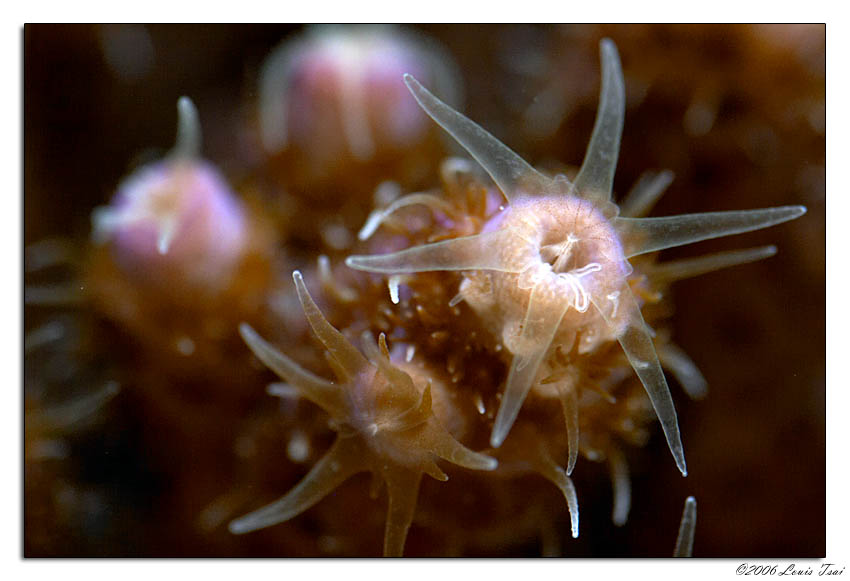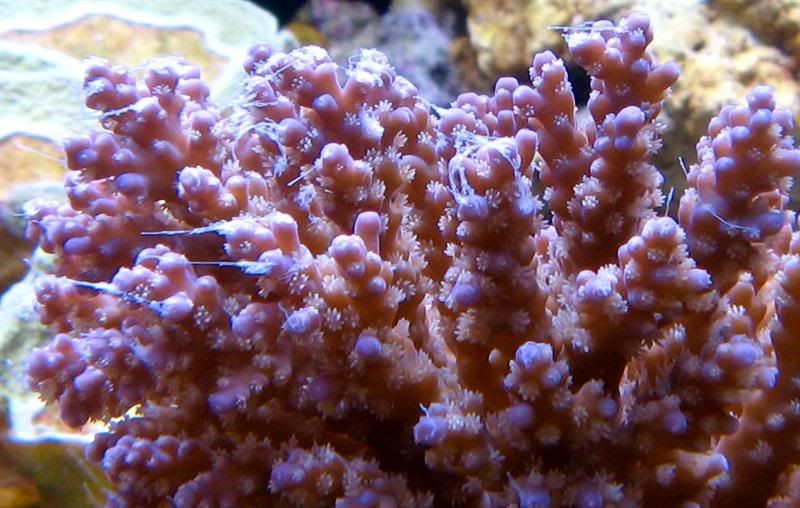

|
|
|
|||||||
|
|
Thread Tools | Search this Thread | Display Modes |
|
#1
|
|||
|
|||
|
We all love to discuss polyp extension (PE) and from my own experience most Acropora species show this only at night, with a few exceptions. However, I do often observe mesentaric filaments (MF) extended whenever fine particles are available in the water.
As most LPS corals do extend these filaments to claim their territory and capture prey, the question would be, for Acropora and company, what role do they play? What does it mean, when they become extended? I hope we can keep ourselves to actual observations, and not just site information from other literature. A simple exchange with extrapolations in order to amass experiences and better understand what is happening. I have noted a few of my Acroporas are particularly prone to extending their MF, while others rarely show them. The deeper water forms seem to be better able to produce them in quantity, rarely showing their actual polyps during the day. A trigger appears to be releasing particles from my Bryopsis algae when I havest them. A great deal of small material goes into the water column and the MF come out in a few minutes. Another stimulus I've noted is water changes. The reaction is not as strong, but clearly something in the new water/or the actual change is triggering the MF extension. My thoughts at the moment are the coral exptends the MF in order to capture or absorb particles that are present in the water column. As the coral does not do this 24-7, there must be a level of concentration or a particular element involved. What say ye! 
__________________
Jamie V. Cologne |
|
#2
|
|||
|
|||
|
Much of the same thing, actually. They can also use them to digest larger food particles outside of the polyps themselves (observed in Hydnophora spp.). In the case of your algae, it seems to be more of a defense mechanisms, trying to digest any invasive organisms. I wouldn't be surprised at some sort of response with new synthetic seawater, as well. I think it has more to do with actual contact or proximity more than anything, although concentration probably has an impact as well (which it would be more concentrated with greater proximity).
__________________
You've done it now, haven't you? |
|
#3
|
|||
|
|||
|
when an acro fell on a monti i observed the mes.fil.'s out on its surface stinging the monti.
i have some tenuis' that extend them whenever food or my arm is put into the water.
__________________
Anthony red house, up there^ = my tank pics "Use filters" |
|
#4
|
|||
|
|||
|
I recently overdosed MG -- upwards of 1600 ppm or higher, and saw a few corals show this behavior. Actually, the coral most bothered by the overdose where my cali torts--4 separate colonies from different locals all died. I think it was a chemical response, the coral thought it was being stung by a coral close by, and let out it's mesemteric filaments as a defensive mechanism. Every time I have actually witnessed a coral extend it's mesemteric filaments, it's either stress related or warfare related.
pk |
|
#5
|
|||
|
|||
|
in my experiences my blue milli always has MF extended,i have observed A.tenius too but not all the time like the milli
|
|
#6
|
|||
|
|||
|
Proboscis,
A. millipora often has its polyps extended 24-7. Are you sure it is the MF and not just the tentacles? I have but one milli and it never extends its MF, with the tentacles half-out during the day and fully extended at night.
__________________
Jamie V. Cologne |
|
#7
|
|||
|
|||
|
Pardon my lack of knowledge on the subject...my millies seem to have polyps extended pretty much always, but at night I see little thread-like filaments extended from the tips of branches, where I usually don't see anything. Are these MF? I only see these at night, and I pretty much see them every night, FWIW.
jds Quote:
|
|
#8
|
|||
|
|||
|
I think what you are seeing are MF. They are finer and longer than the typical tentacles. I often see them at night coming from the axial corallites of various Acroporas. A. millipora is one of the few that do present their tentacles over the entire day. Most Acroporas are nocturnal, although many do seem to show PE durning the day in the aquarium, while on the reef they wouldn't do this. Perhaps this is a predator adaptation.
__________________
Jamie V. Cologne |
|
#9
|
|||
|
|||
|
my experience is that the MF's come out on acros when something ticks them off. I have seen the MF's:
-after fragging -when I have dusted and a really lot of dust has been kicked up -when it decides to nuke its neighbor downstream. Their feeding response is all polyp extension (for me) I do not like seeing Acro MF's, EVER. It only means trouble in one form or another.
__________________
Only Dead fish swim with the current. |
|
#10
|
|||
|
|||
|
I think I've seen this on a green A. millepora frag I have. White stringy things coming from the polyps. If so, I've only seen this when cyclopeeze is in the water. I've wondered if it was a feeding response.
Interesting topic - thanks for starting it.
__________________
Thirsting for knowledge in a world full of salt water |
|
#11
|
|||
|
|||
|
Acropora sp.& Montipora sp. (and likely most other "SPS" corals) also extend their mesenterial filaments along the encrusting boundaries of the colony. I.e. an encrusting Montipora of mine will "clean" its surroundings before encrusting over. In this case against a blue Acropora sp.
This is a photo of an Acropora sp. taken after lights out. You can see the extended polyp on the tip of the coral, along with mesenterial filaments for digestion: 
__________________
Louis Tsai |
|
#12
|
|||
|
|||
|
I've generally seen them when PO'ed as well, or when in physical contact with another coral + getting aggressive on it .... but I have seen them a few times as part of a feeding response [like below].
Seem pretty multi-use IMO: eating, warring, stressing, ... FWIW, my pics of messenteries:   And my bubble's messenteries, for comparison  
__________________
read a lot, think for yourself |
|
#13
|
|||
|
|||
|
Great photos! Mark and Louis.
I tlooks as though there is a multipurpose function to the MF. If they are mainly a defense mechanism, then perhaps absorbing nutrients or particle capture is a further developement from an original defense mechanism. After all, Mother Nature is very efficient and multipurpose oriented. It would be nice to know if the MF can actually absorb through osmosis various nutrients. Logically, all parts of the coral tissue should have this capability, due to the fine structure of the wall tissues. Perhaps in our nutrient poor aquariums they sense a sudden bounty and create as much surface area as possible to take full advantage? I'm learning a lot, here! Thanks all for pitching in. 
__________________
Jamie V. Cologne |
|
#14
|
|||
|
|||
|
I have not figured out exactly why but I have one acro that does it all the time when the lights are on. I have moved it since the pic and it still does it but not as much.

|
|
#15
|
|||
|
|||
|
I've only seen this in stress situations. What are your water parameters? Is it in direct current? Otherwise it looks healthy!
__________________
Jamie V. Cologne |
|
#16
|
|||
|
|||
|
[
IMO this is dead on accurate. QUOTE] href=showthread.php?s=&postid=9639763#post9639763 target=_blank>Originally posted by MiddletonMark I've generally seen them when PO'ed as well, or when in physical contact with another coral + getting aggressive on it .... but I have seen them a few times as part of a feeding response [like below]. Seem pretty multi-use IMO: eating, warring, stressing, ... FWIW, my pics of messenteries:   And my bubble's messenteries, for comparison   [/QUOTE] [/QUOTE]
__________________
And God said let the water teem with living creatures and he saw that it was good. |
|
#17
|
|||
|
|||
|
I've only seen them do it when I've kicked up a detritus storm or when feeding my fish. They're never out for too long and I don't have any idea as to their function[s] either
 Don't seem to have any adverse effects and I've never noticed the MF's to be a precursor to any tank/coral problems like F-n-Frags said... They're cool little MF's 
__________________
Dave :~) |
|
#18
|
|||
|
|||
|
Quote:
|
|
#19
|
|||
|
|||
|
I've seen them in most situations above but the one that sticks out as a surprise to me is the Mg spike. I did a WC and at same time bumped my Mg and my biggest tort and tenuis have had MF galore ever since, and are going downhill from there. I wonder if it was general stress from change in water conditions or the Mg. I used Seachem Mg dry supplement that I believe Randy said isn't well balanced. Any way you slice it i get nervous when i seem them.
|
|
#20
|
|||
|
|||
|
There is another thread running in German language which has a neat shot of S. hystrix showing MF, sort of as clusters. I will attempt to get the shot for this site and post it.
The address, if you want to see it is: http://www.meerwasserforum.com/threa...780#post356780
__________________
Jamie V. Cologne |
|
#21
|
|||
|
|||
|
The following shot shows MF being extended in clusters from a S. hystrix. Photo by Dietmar Schauer. Apparently, these have only been seen in the evening hours and disappear by morning.

__________________
Jamie V. Cologne |
|
#22
|
|||
|
|||
|
The following shot shows MF being extended in clusters from a S. hystrix. Photo by Dietmar Schauer. Apparently, these have only been seen in the evening hours and disappear by morning.

__________________
Jamie V. Cologne |
|
#23
|
|||
|
|||
|
Good thread. Those are some great macro shots!

__________________
Think for yourself. Question authority. |
|
#24
|
|||
|
|||
|
tylorarm, do you have any tissue loss? If so, did it start at the axial corallite and move down the branches?
|
|
#25
|
|||
|
|||
|
Quote:
__________________
read a lot, think for yourself |
| Thread Tools | Search this Thread |
| Display Modes | |
|
|